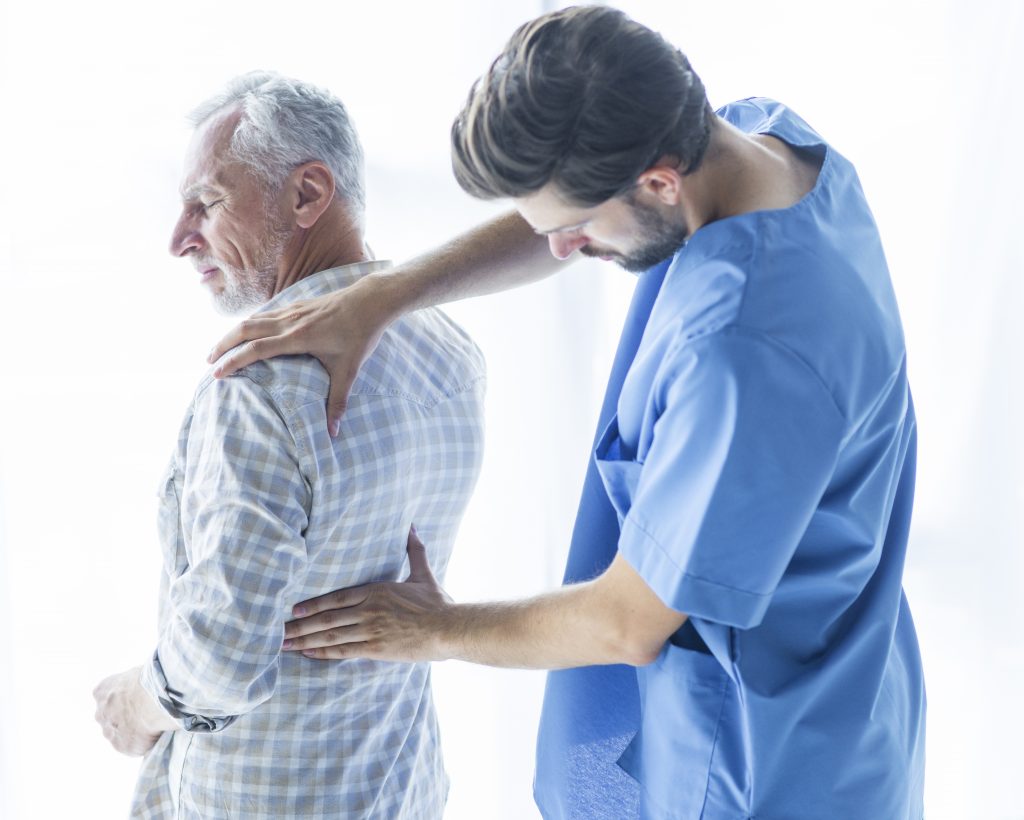Low back pain treatment groups based on non-pathoanatomic model

Prevalence of low back pain is estimated up to 80% of the population will experience some form of low back pain in their lives
Most will have complete resolution not requiring intervention
Between 10% and 30% will have chronic symptoms (greater than 3 months)
Up to 5% of people with low back pain will become disabled
Largest predictor of low back pain is presence of a previous episode
Using non-anatomic model for diagnosis in non-specific low back pain
- Using
mechanical evaluation rather than trying to find specific anatomical culprit can
be more effective in diagnosis - Treatment
based on separating patients into syndromes or treatment groups - Judge
whether treatment is effective based on a change in the comparable sign
Extension-based exercise
- Symptoms
worsen or peripheralize with prolonged or repeated flexion - Symptoms
improve or centralize with prolonged or repeated extension - Treatment includes end-range
extension, education on avoidance of flexion. Patients may benefit from
mobilization
Flexion-based exercise
- Usually
older age (>50 years) - Symptoms
worsen with prolonged or repeated extension - Symptoms
improve with prolonged or repeated flexion - Imaging
evidence of lumbar spinal stenosis - Treatment includes exercise to
address flexibility, strength. Patients may benefit from mobilization, body
weight supported ambulation
Lateral shift
- Both
flexion and extension worsen symptoms - Side
glide motion relieves or centralizes symptoms - Patient
may have visible frontal plane deformity (lateral deviation of shoulder girdle
relative to pelvis in standing) - Treatment includes correction of
lateral shift deformity, end-range side glide
Manipulation
- Onset
of symptoms < 16 days ago - Fear
Avoidance Belief Questionnaire Work Subscale score < 19 - No
symptoms distal to the knee - One
or more hypomobile segments in lumbar spine - Hip
internal rotation range of motion > 35° at least one side - Treatment includes manipulation of
lumbar spine, active range of motion exercise
Stabilization exercise
- Usually
younger age (<40 years) - Greater
flexibility - Instability
catch reported on motion testing in sagittal plane - Positive
prone instability test - Treatment includes progression from
individual activation of deep stabilizing muscles to co-contraction of flexors
and extensors, static to dynamic movements, unloaded to loaded exercise
Traction
- Symptoms
of nerve root compression - No
movement decreases or centralizes symptoms - Treatment focuses on auto traction or
mechanical traction recommended in prone position
Therex Portal lists exercises to treat low back pain into treatment groups based on 1) Directional Preference 2) Mobility Deficit and 3) Movement Coordination Deficit. Here is an example of flexion-based exercise and an extension-based exercise.
Extension Based Exercise
Flexion Based Exercise
Sign up to Therex Portal to learn more and treat your patients effectively.
Register to our free trial at – https://therexportal.org/signup?type=trail
References
- Beattie P, Nelson R, Michener L, Cammarata J, Donley
J. Outcomes after a prone lumbar traction protocol for patients with activity-limiting
low back pain: A prospective case series study. Arch Phys Med Rehabil. 2008;89(2):269-74. - Brennan G, Fritz
J, Hunter S, Thackeray A, Delitto A, Erhard R. Identifying subgroups of
patients with acute/subacute “nonspecific” low back pain: Results of a
randomized clinical trial. Spine.
2006;31(6):623-31.
- Childs
J, Fritz J, Flynn T, Irrgang J, Johnson K, Maikowski G, Delitto A. A clinical
prediction rule to identify patients with low back pain most likely to benefit
from spinal manipulation: A validation study. Ann Intern Med. 2004;141(12):920-8. - Flynn
T, Fritz J, Whitman J, Wainner R, Magel J, Rendeiro D, Butler B, Garber M,
Allison S. A clinical prediction rule for classifying patients
with low back pain who demonstrate short-term improvement with spinal
manipulation. Spine.
2002;27(24):2835-43. - Freburger
J, Holmes G, Agans R, Jackman A, Darter J, Wallace A, Castel L, Kalsbeek W,
Carey T. The rising prevalence of chronic low back pain. Arch Intern Med. 2009;169(3):251-8. - Fritz J, Brennan
G, Clifford S, Hunter S, Thackeray A. An examination of the reliability of a
classification algorithm for subgrouping patients with low back pain. Spine. 2006;31(1):77-82. - Fritz J, Cleland J, Childs J.Subgrouping patients with low back pain: evolution of a
classification approach to physical therapy. J Orthop Sports Phys Ther. 2007;37(6):290-302. - Johannes C, Le T, Zhou X, Johnston J, Dworkin R. The
prevalence of chronic pain in United States adults: Results of an
internet-based survey. J Pain. 2010;11:1230-9. - Long A, Donelson
R, Fung T. Does it matter which exercise? A randomized control trial of
exercise for low back pain. Spine. 2004;29(23):
2593-602. - McKenzie R, May S. The Lumbar Spine: Mechanical Diagnosis & Therapy. 2nd
ed. Waikanae, NZ: Spinal Publications New Zealand Ltd; 2003. - Tygiel P, Smith
B, Robertson E, Shropshire M, Thorsen T. Misguided
Guidelines for Low Back Pain Interventions. J
Man Manip Ther. 2008;16(3):182–184.
Author- Kris Heintzelman PT, DPT, OCS.
If you are experiencing any of the above symptoms, search our provider list to get treated effectively.
